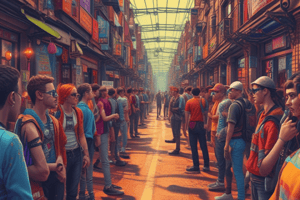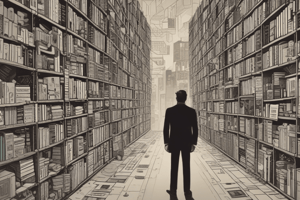Podcast
Questions and Answers
What is one of the main functions of laws in society?
What is one of the main functions of laws in society?
- To resolve conflict and maintain social order (correct)
- To limit the number of social interactions
- To promote every individual's personal interests
- To discourage cultural diversity
Which of the following statements is true regarding deviance?
Which of the following statements is true regarding deviance?
- Deviance is strictly defined by politicians.
- Deviant actions are universally condemned across all cultures.
- All deviant behaviors are considered criminal.
- Deviance can sometimes align with social norms. (correct)
Who is implicated in defining what is considered deviant behavior?
Who is implicated in defining what is considered deviant behavior?
- Governments, scientists, and media (correct)
- Only educational institutions
- Students and children
- Only legal authorities and police
What aspect of law does sociology focus on?
What aspect of law does sociology focus on?
How do classical theories explain crime causation?
How do classical theories explain crime causation?
Which behavior is categorized as deviant in the given context?
Which behavior is categorized as deviant in the given context?
What is a characteristic of criminal behavior in the context of social control?
What is a characteristic of criminal behavior in the context of social control?
What theory attributes criminal behavior to supernatural forces?
What theory attributes criminal behavior to supernatural forces?
What does the concept of felicific calculus relate to in terms of rational choice?
What does the concept of felicific calculus relate to in terms of rational choice?
Which of the following is NOT a characteristic of biological determinism?
Which of the following is NOT a characteristic of biological determinism?
What does social disorganization theory emphasize as a major cause of crime?
What does social disorganization theory emphasize as a major cause of crime?
According to social process theories, what is the primary cause of learning criminal behavior?
According to social process theories, what is the primary cause of learning criminal behavior?
What is a significant criticism of early biological theories of crime?
What is a significant criticism of early biological theories of crime?
How does conflict theory perceive the criminal justice system?
How does conflict theory perceive the criminal justice system?
What is a key aspect of labeling theory in the context of crime?
What is a key aspect of labeling theory in the context of crime?
What distinction is made between street crime and suit crime?
What distinction is made between street crime and suit crime?
Which theory suggests that societal structure contributes to the frequency of crime?
Which theory suggests that societal structure contributes to the frequency of crime?
What is a consequence of labeling an individual as deviant in society?
What is a consequence of labeling an individual as deviant in society?
Flashcards
Deviance
Deviance
Actions violating social norms. May or may not be a crime.
Crime
Crime
Behavior violating laws, requiring social intervention and codified in law.
Social Norms
Social Norms
Rules and expectations about acceptable behavior within a society.
Social Control
Social Control
Signup and view all the flashcards
Defining Deviance
Defining Deviance
Signup and view all the flashcards
Explaining Crime Causation
Explaining Crime Causation
Signup and view all the flashcards
Classical Theories of Crime
Classical Theories of Crime
Signup and view all the flashcards
Demonology
Demonology
Signup and view all the flashcards
Felicific Calculus
Felicific Calculus
Signup and view all the flashcards
Jeremy Bentham
Jeremy Bentham
Signup and view all the flashcards
Biological Determinism
Biological Determinism
Signup and view all the flashcards
Phrenology
Phrenology
Signup and view all the flashcards
Atavistic Man
Atavistic Man
Signup and view all the flashcards
Somatotype
Somatotype
Signup and view all the flashcards
Social Disorganization
Social Disorganization
Signup and view all the flashcards
Collective Efficacy
Collective Efficacy
Signup and view all the flashcards
Labelling Theory
Labelling Theory
Signup and view all the flashcards
Conflict Theory
Conflict Theory
Signup and view all the flashcards
Study Notes
Deviance and Crime
- Deviance encompasses actions violating social norms, encompassing appearance, relationships, sexuality, lifestyle choices, etc.
- Crime is codified deviant behavior requiring social control and intervention.
- Laws aim to resolve conflicts, maintain order, and provide a sense of quality/fairness.
- Laws address values, interactions, patterns, and ideologies.
- Sociology and law examines norms, social controls, human rights, and power structures.
- Crime involves codified behavior requiring social control.
- Murder, assault, and theft are examples of crimes.
- Not all acts of deviance are considered criminal.
- Deviance includes acts like smoking during pregnancy, relationships between colleagues with age gaps, and possession of weapons.
Defining Deviance
- Howard Becker (1966) argued the act itself isn't deviant, but societal reaction to it makes it deviant.
- Certain individuals, groups, or institutions (e.g., politicians, media, governments) define what is deviant.
Explaining Crime Causation
- Theories of crime causation examine factors influencing criminal behavior, attributing it to factors like supernatural forces, social interactions, or individual differences.
- Classical theories focus on free will and rational choice, suggesting criminals weigh the potential gains and losses of their actions, and crime results from conscious decisions.
- Biological theories attribute criminality to physiological factors, innate predispositions, or genetic influences, but are considered flawed and largely discredited.
- Sociological theories analyze crime from macro perspectives, focusing on group behaviors and social structures as causes of crime, including issues such as social disorganization, labeling, and conflict.
Types of Crime
- Street crime: more likely to go undetected, affect a larger population, and have significant social impact, receiving less harsh sanctions in comparison.
- "Suit crime" or white-collar crime: more likely to go unnoticed and affect a greater number of people, with greater economic and social impact and less harsh sanctions.
Key Theories of Crime
- Social Disorganization Theory explores how neighborhood characteristics contribute to crime rates.
- Social Process Theory examines how socialization and interactions shape criminal behavior.
- Labeling Theory focuses on how societal reactions to deviance influence subsequent behavior.
- Conflict Theory examines how the political and economic systems influence the administration of justice.
Studying That Suits You
Use AI to generate personalized quizzes and flashcards to suit your learning preferences.




